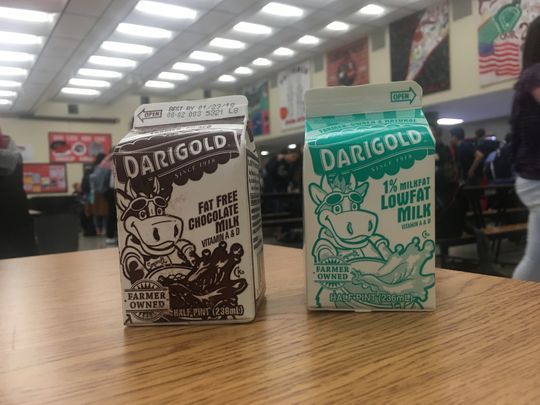The debate over the whether to serve chocolate milk in school is hardly new.
A recent recommendation by the Kitsap Public Health District's top health official affirms the position that the nutritional benefits of flavored milk outweigh the risks of the added sugar.
Dr. Susan Turner, health officer for the agency, reviewed scientific studies and statements by national health experts and concluded, "The current state of science does not support eliminating chocolate milk from school lunches."
Turner, in a report to the Kitsap Public Health Board earlier this month, said she was spurred to review research on chocolate milk in schools by comments from parent Amber Ellis.
Ellis, formerly of Bremerton, had urged the health board in June to pressure school districts to remove excess sugar from lunches, primarily in the form of chocolate milk. Ellis was particularly concerned that low-income students, who typically eat both lunch and breakfast at school, are at greater risk of obesity and other health impacts from added sugar in their diets. Ellis also spoke to the Bremerton school board, which took no action to change its policy.
"Our position continues to be that the benefits of chocolate milk far outweigh the negatives, particularly in high poverty areas like ours," spokeswoman Patty Glaser said.
Turner, in her report to the health board, noted that childhood obesity is a "significant concern." In 2016, 26 percent of Kitsap eighth-graders were overweight or obese. Added sugars in food and drinks have been implicated as a primary cause of obesity and related health issues. But the experts do not consider chocolate milk in the same category as beverages like regular soda, fruit drinks, sports drinks, or sweetened tea and coffee drinks, Turner said.
Unlike sugar-sweetened beverages, which are mostly or entirely empty calories, milk contains calcium and vitamin D, needed for healthy bone development. Low bone density can cause fragile, brittle bones, especially later in life, resulting in fractures.
Some of the studies Turner looked at showed decreased milk consumption when chocolate milk was removed from the menu. A 2015 study of elementary school children in Saskatoon, Canada, found a 48 percent decline in total milk consumption when flavored milk was eliminated.
"Calcium consumption, especially for girls and especially during adolescence, is critical to peak development of bone mass," Turner said. "It's important to note that removing chocolate milk from the school lunch menu can actually be damaging."
Researcher Marlene Schwartz challenges that notion, citing research she conducted through the University of Connecticut’s Rudd Center for Food Policy & Obesity. Schwartz and her colleagues found plain milk consumption rebounded over two years at two K-8 public schools where chocolate milk had been removed from the menu. During the first year, 50 percent of students drank plain milk, compared with 72 percent the second year. Incentives, like random prizes from stickers on milk cartons, had no measurable impact on consumption.
Schwartz said in any study, there will be some children who won’t drink milk at all for varying reasons. Some ethnic groups, for example, drink less milk than others. Nutritional policies should be determined at the district level, to factor in the unique make-up of the student population, as well as the needs and desires of families, Schwartz said.
Schwartz said parents looking into the issue of chocolate milk in schools should consider the funding sources of research studies, some of which have ties to the dairy industry. That doesn't necessarily invalidate the study; it just needs to be weighed, she said.
While some districts around the country have gone the plain-milk-only route, Kitsap County school meal programs universally feature chocolate milk.
“I’m of the opinion that students should have the option of flavored milk, especially at lunch,” said Dan Blazer, head of North Kitsap School District’s nutrition program. “The benefits you get from drinking milk regardless of the added sugar far outweigh the negative aspect of kids not taking milk at all.”
Sugar from all sources is evaluated as part of the total calories in weekly menus, which follow federal nutrition guidelines, Blazer said. The district offers nonfat chocolate milk at breakfast for grades 6-12 and nonfat chocolate milk at lunch for all grade levels in addition to nonfat and 1 percent white milk.
An easing of school lunch guidelines under the Trump administration would allow schools to serve 1 percent chocolate milk, but so far no districts in Washington State have sought the waiver to do so, according to the Office of the Superintendent of Public Instruction.
Recent invoices from Central Kitsap School District show kids' overwhelming preference for chocolate milk. Roughly 21,000 units of milk were purchased for a five-day period, roughly 18,000 of which were chocolate. The district doesn’t track milk consumption. Sam Blazer, director of food and nutrition, notices many students don't take milk at all.
“I think really what it boils down to, it’s the role of a school district to provide nourishment to help kids learn,” Blazer said. “To do that, we have to find the tricky balance of finding items kids will like and eat.”
So, how much sugar is in chocolate milk, and how does that compare to sugar-sweetened beverages?
All milk contains naturally occurring sugars, about 12 grams per 8-ounce serving. The formulation of chocolate milk varies by brand, commonly about 12 grams of added sugar. The American Heart Association, cited in Turner’s research, endorses the recommendation that children limit their consumption of added sugars to no more than 25 grams per day (roughly six teaspoons).
A 12-ounce can of soda contains roughly 37 grams of added sugar, according to the U.S. Department of Agriculture. That's 25 grams per 8-ounce serving, but figure that kids aren't likely to stop at one cup. Even “reduced sugar fruit-flavored drinks” have 12 grams of sugar per 8-ounce serving, the USDA reports.
The AHA concludes that added sugars can safely be consumed in low amounts. Most children, however, go above the recommendation — by some estimates way above. And chocolate milk is not the main culprit, Turner’s research shows.
Dairy products, which includes flavored milk, account for 4 percent of added sugars in the American diet, according to the USDA. Beverages (other than 100 percent fruit juice) account for 47 percent. Sweets and snacks are 31 percent.
Studies cited by Turner show young people's milk consumption goes down the more sugar-sweetened beverages they drink.
Turner applauds parents like Ellis who are looking into their children’s nutrition. She’d like people to consider the question of chocolate milk in the big picture. “There are many other sources of added sugar in children’s diets,” she said. “It’s really important to consider all the sources of sugar in a child’s diet. It’s super important to look at it holistically and look at the recommended daily allowances.”
"I am grateful to Dr. Turner for exerting the time and effort on our behalf," said Ellis, now living in Tacoma.
Ellis said she is still concerned about chocolate milk in school lunches but she and her husband Daniel have focused their efforts on candy and other sweetened treats offered in classrooms and school events.
For more information on nutrition, visit https://www.choosemyplate.gov/.


